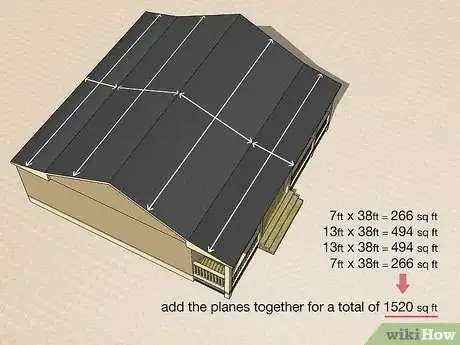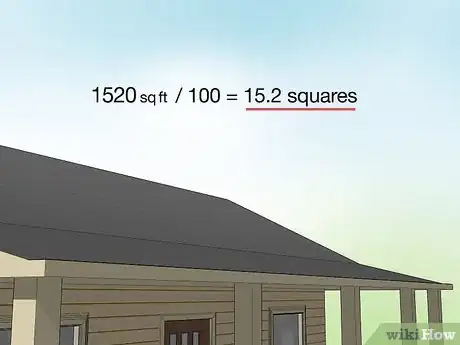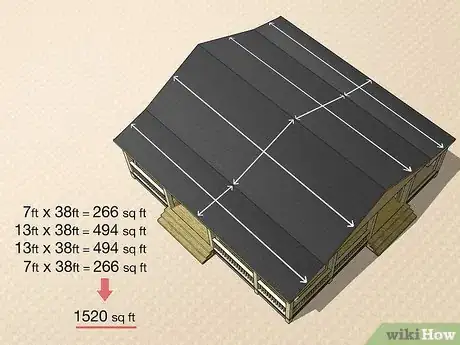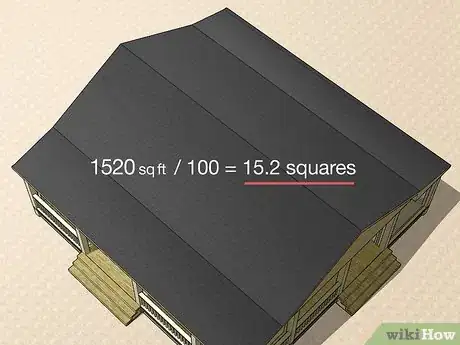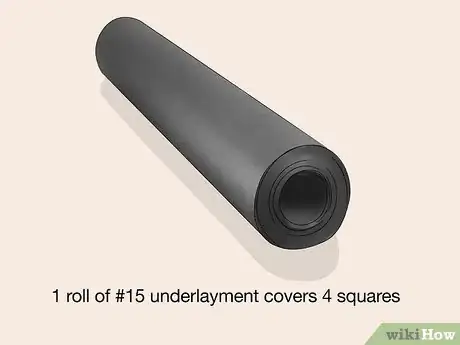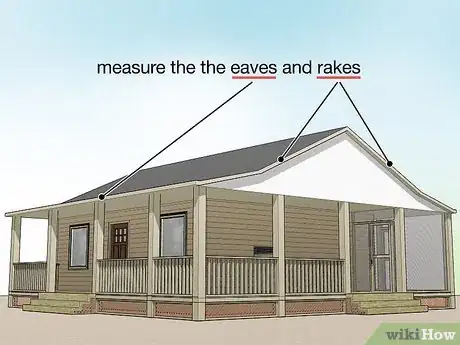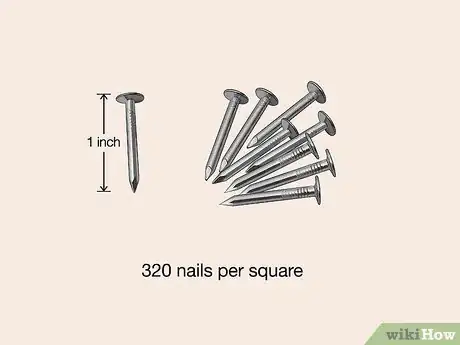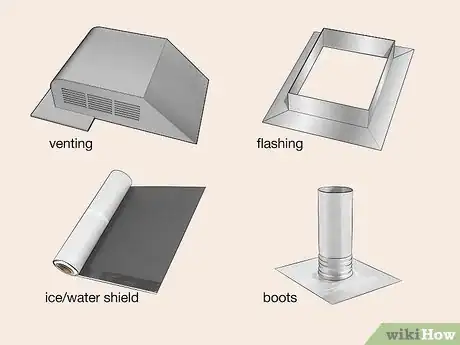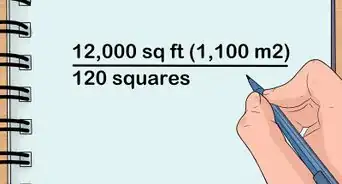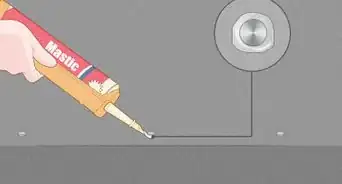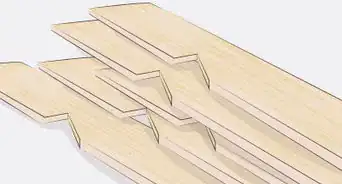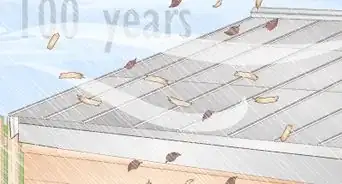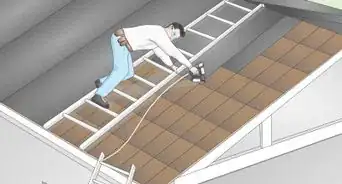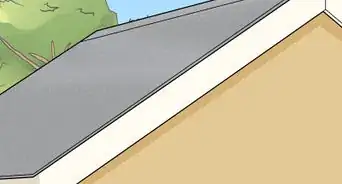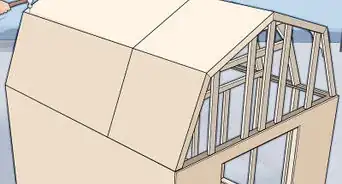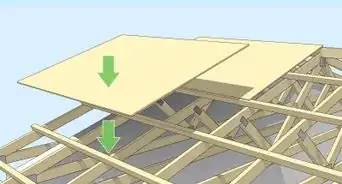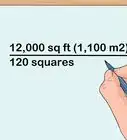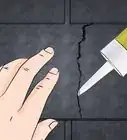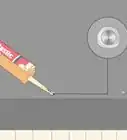This article was co-authored by David Bitan. David Bitan is a roofing professional, licensed contractor, and the owner and founder of Bumble Roofing based in Southern California. With over 12 years of construction industry experience, David specializes in restoring, repairing, and maintaining residential, commercial, and industrial roofs. With over 60 years of combined experience, Bumble Roofing provides easy, friendly services to structures including residential, commercial, industrial, multi-family, and government buildings along with hospitals, hotels, and churches.
wikiHow marks an article as reader-approved once it receives enough positive feedback. This article received 16 testimonials and 84% of readers who voted found it helpful, earning it our reader-approved status.
This article has been viewed 737,239 times.
Knowing how to estimate roofing materials is important. Not only will it help eliminate waste, but it will also ensure that you buy just enough for the roofing job. You’ll have to calculate your roof area, or the overall size of your roof, to determine the amount of materials you’ll need. This wikiHow will show you how to estimate roofing materials for your next project.
Steps
Estimating Shingles
-
1Find the square footage of the roof. Measure the length and width of each portion of the roof, multiply length by width for each plane, and then add the planes together for the total square footage.[1]
- If you have a simple gable roof, you’ll only need to measure and sum up the 2 planes of the roof. If your roof has dormers, hips, or other complex elements, don’t forget to take the area of those additional parts of the roof into account.
- Because of these slopes and pitches, the square footage of your roof will not be the same as the square footage of your home.[2]
- Websites like Eagleview use satellite imagery to help you safely measure your roof.[3]
-
2Determine the total number of squares. Divide the total footage by 100 to determine the number of “squares” in the roof.Advertisement
-
3Determine the bundles of shingles needed to cover the roof. It takes 3 bundles to cover a square if you use 3-tab shingles, the most common type.[4]
-
4Account for waste. Add 10% to the shingle estimate to account for waste.
- If your roof has hips and valleys, make it 15% because of waste in cutting shingles to fit the valleys.
Estimating Felt Underlayment (Tar Paper)
-
1Find the square footage of the roof. Measure the length and width of each portion of the roof, multiply length by width for each plane, and add the planes together for the total square footage.
- If you’re just replacing some old shingles, you may not need to purchase underlayment. However, this is a must if you’re installing a new roof.
-
2Find the number of squares. Roofers measure surfaces in squares of 100 square feet (9.29 square meters). Divide the total footage by 100 to find the number of squares in the roof.
-
3Determine the number of rolls of underlayment needed. The #15 type is most commonly used, and one roll of #15 underlayment covers 4 squares.[5]
- If you’re using #15 underlayment and your roof slope is greater than 4:12, use 1 layer. If the slope is between 3:12 and 4:12, double the amount and put down 2 layers.
Estimating Other Materials
-
1Measure for drip edge. This metal strip, which goes beneath the underlayment, protects the edge of the roof from rot. You'll need the measurements of the rakes and eaves of the roof (side edges and bottom edge). Use a rake edge for the side of the house as well.
-
2Estimate how many roofing nails you'll need. At 4 nails per field shingle, that’s about 320 nails per square.[6] You will also need 5 nails for each starter shingle.
- For high-wind areas, use 6 nails per shingle, or 480 nails per square.
- Inquire at the hardware store regarding the size of nail you’ll need and how many pounds or kilograms you’ll need of that size; the number of nails per pound or kg differs. The nails should be long enough to go 3⁄4 inch (1.9 cm) into the roof.
- Inquire at the hardware store regarding the amount of underlayment nails required. Always use 1 in (2.5 cm) nails. The nails should be 12 inches (30 cm) apart along the edges and 24 inches (61 cm) apart in the middle of the underlayment strip.
-
3Gauge the amount of hip and ridge cap shingles. While you can order special hip and ridge cap shingles, you can make your own by cutting a 3-tab shingle into 3 pieces. A bundle of 3-tab shingles will cover 35 feet (11 m).[7]
-
4Take other miscellaneous costs into account. Depending on the type of roof and your supplier, you may have some other costs to consider. Some of your other costs may include:
- Venting. A venting system plays a crucial role in maintaining the integrity of the roof during hot and cold weather.[8] *Flashing. Aluminum or steel material that is used to cover roof joints and prevent water from getting in.[9]
- Ice/water shield. An ice shield is only necessary if you live in an area that is prone to ice and snow in the winter.[10]
- Boots. These are required to go around any pipes sticking through the roof.
- Delivery charge for your materials (if there is one).
How Do You Measure the Dimensions of Your Roof?
Expert Q&A
Did you know you can get expert answers for this article?
Unlock expert answers by supporting wikiHow
-
QuestionWhat is the purpose of roof vents?
 David BitanDavid Bitan is a roofing professional, licensed contractor, and the owner and founder of Bumble Roofing based in Southern California. With over 12 years of construction industry experience, David specializes in restoring, repairing, and maintaining residential, commercial, and industrial roofs. With over 60 years of combined experience, Bumble Roofing provides easy, friendly services to structures including residential, commercial, industrial, multi-family, and government buildings along with hospitals, hotels, and churches.
David BitanDavid Bitan is a roofing professional, licensed contractor, and the owner and founder of Bumble Roofing based in Southern California. With over 12 years of construction industry experience, David specializes in restoring, repairing, and maintaining residential, commercial, and industrial roofs. With over 60 years of combined experience, Bumble Roofing provides easy, friendly services to structures including residential, commercial, industrial, multi-family, and government buildings along with hospitals, hotels, and churches.
Roofing Contractor & Maintenance Professional
-
QuestionIs the square footage of a house the same as the roof?
 David BitanDavid Bitan is a roofing professional, licensed contractor, and the owner and founder of Bumble Roofing based in Southern California. With over 12 years of construction industry experience, David specializes in restoring, repairing, and maintaining residential, commercial, and industrial roofs. With over 60 years of combined experience, Bumble Roofing provides easy, friendly services to structures including residential, commercial, industrial, multi-family, and government buildings along with hospitals, hotels, and churches.
David BitanDavid Bitan is a roofing professional, licensed contractor, and the owner and founder of Bumble Roofing based in Southern California. With over 12 years of construction industry experience, David specializes in restoring, repairing, and maintaining residential, commercial, and industrial roofs. With over 60 years of combined experience, Bumble Roofing provides easy, friendly services to structures including residential, commercial, industrial, multi-family, and government buildings along with hospitals, hotels, and churches.
Roofing Contractor & Maintenance Professional
-
QuestionHow do I calculate how much drip edge I need for a gable roof?
 Mark SpelmanMark Spelman is a General Contractor based in Austin, Texas. With over 30 years of construction experience, Mark specializes in constructing interiors, project management, and project estimation. He has been a construction professional since 1987.
Mark SpelmanMark Spelman is a General Contractor based in Austin, Texas. With over 30 years of construction experience, Mark specializes in constructing interiors, project management, and project estimation. He has been a construction professional since 1987.
Construction Professional
References
- ↑ http://www.finehomebuilding.com/2002/11/01/dont-fall-short-on-shingles-how-to-estimate-materials-for-roofing-projects
- ↑ David Bitan. Roofing Contractor & Maintenance Professional. Expert Interview. 14 July 2020.
- ↑ David Bitan. Roofing Contractor & Maintenance Professional. Expert Interview. 14 July 2020.
- ↑ http://www.finehomebuilding.com/2002/11/01/dont-fall-short-on-shingles-how-to-estimate-materials-for-roofing-projects
- ↑ http://www.roofhelp.com/calcmatASx.html
- ↑ http://www.roofhelp.com/calcmatASx.html
- ↑ http://www.roofhelp.com/calcmatASx.html
- ↑ David Bitan. Roofing Contractor & Maintenance Professional. Expert Interview. 14 July 2020.
- ↑ https://www.thisoldhouse.com/ideas/roof-flashing
- ↑ http://www.roofhelp.com/calcmatASx.html
- ↑ David Bitan. Roofing Contractor & Maintenance Professional. Expert Interview. 14 July 2020.
- ↑ http://roofingtutor.com/guides/replacing-shingles-on-low-sloped-roofs-vs-steep-sloped-roofs-which-costs-more.html
About This Article
To estimate roofing materials, start by finding the total square footage of the roof and divide the number by 100 to determine the number of "squares" in the roof. Since it takes 3 bundles of shingles to cover a square, plan to purchase 3 bundles for each square. Then, add 10% to the number to account for waste. Using the number of squares that you previously counted, plan for 1 roll of under-paper to cover 4 squares. For tips on estimating other materials, like nails and ridge shingles, read on!
